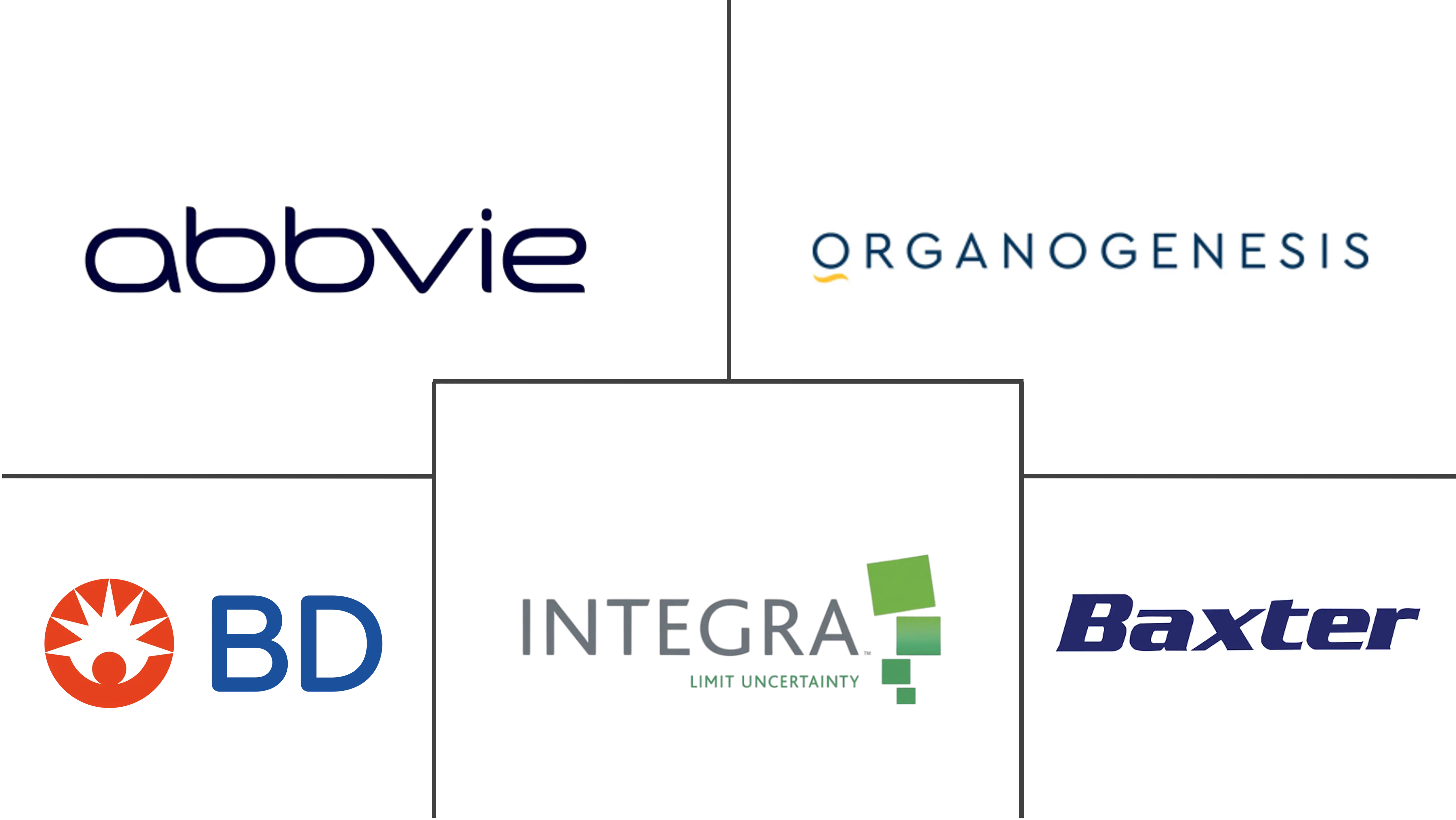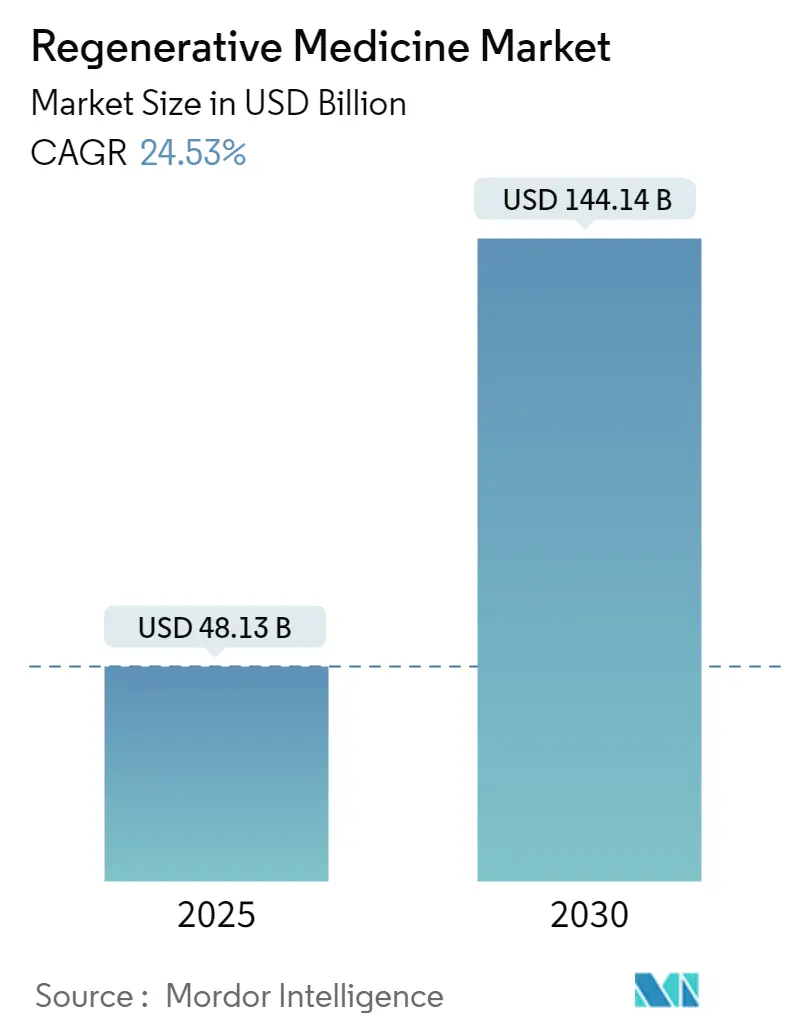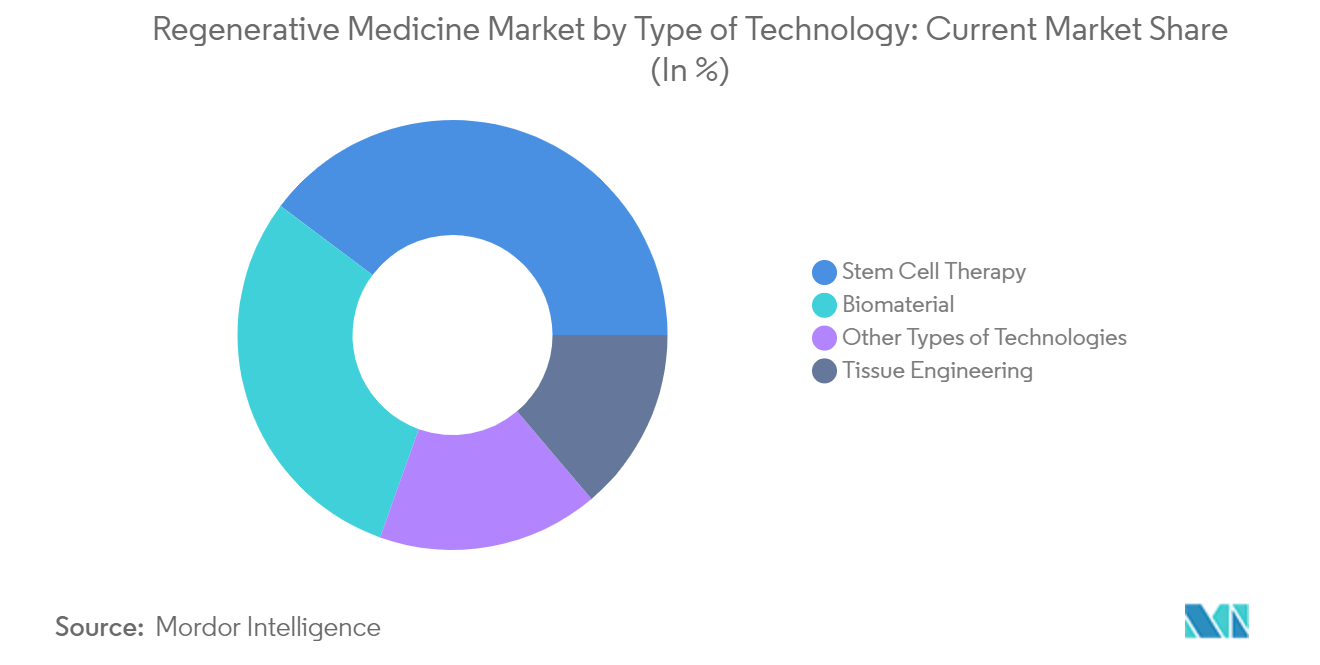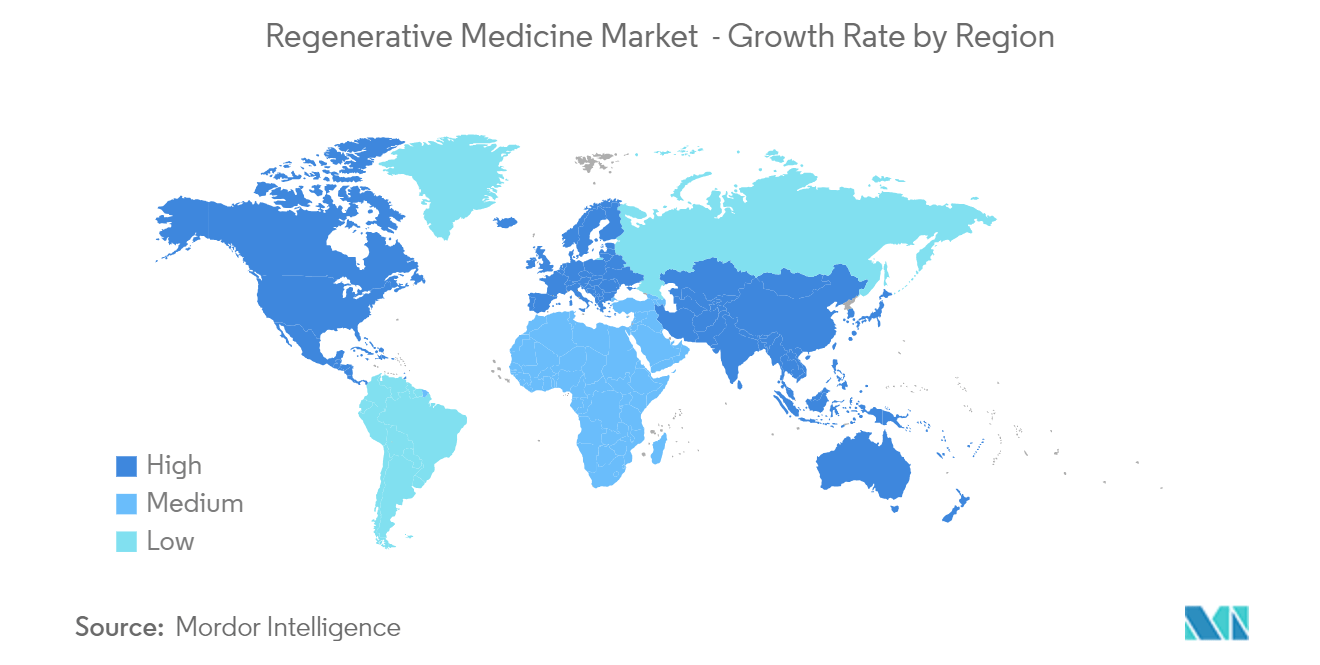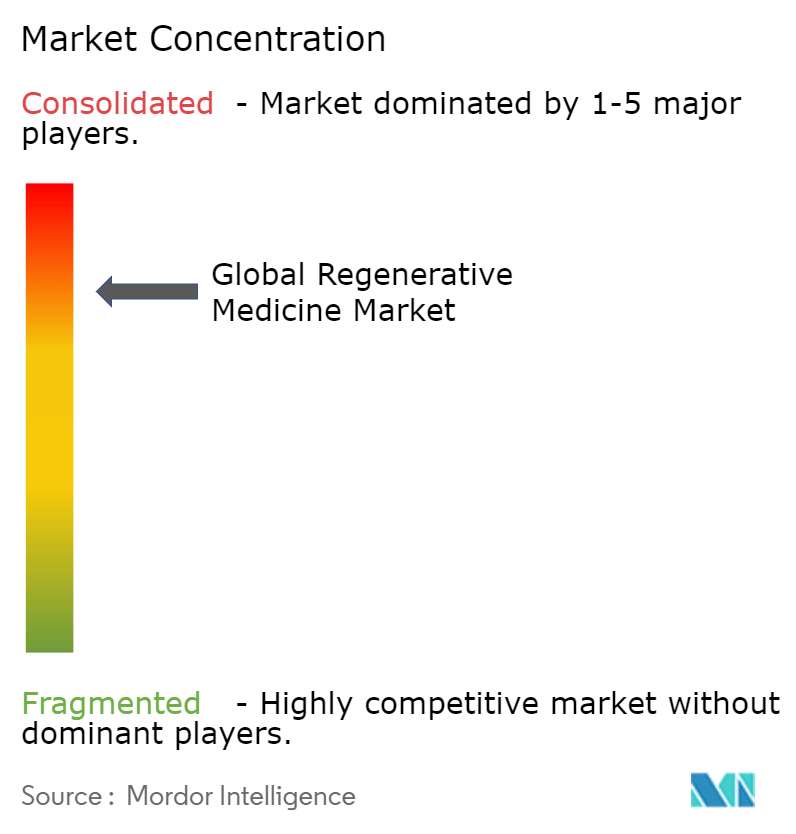Regenerative Medicine Market Analysis
The Regenerative Medicine Market size is estimated at USD 48.13 billion in 2025, and is expected to reach USD 144.14 billion by 2030, at a CAGR of 24.53% during the forecast period (2025-2030).
Global Regenerative Medicine Market Industry Growth Drivers:
This global Regenerative Medicine Market is experiencing robust growth, propelled by two primary factors: the rising adoption of Stem Cell Therapy and technological innovations in the field. With an aging global population and an increase in chronic diseases, Regenerative Medicines are seen as a breakthrough approach in addressing previously incurable conditions. This shift is expected to drive substantial Regenerative Medicine Market Growth and reshape treatment paradigms.
Increasing Adoption of Stem Cell Technology:
Stem Cell Therapy is rapidly transforming the Regenerative Medicine Industry, marking a major shift in therapeutic approaches. Stem cells have a unique capacity to regenerate damaged tissues, positioning them as a cornerstone of modern medical innovation. Industry analysis reveals that numerous research grants have been awarded to develop Stem Cell Therapy and Gene Therapy clinics, enhancing patient access and promoting global collaboration. Notably, new commercial ventures, such as off-the-shelf Cell Therapy products for knee osteoarthritis, exemplify the growing accessibility of stem cell therapies. These advancements bridge the gap between research and clinical application, expanding the reach of the Regenerative Therapies Market.
Technological Advancements in Regenerative Medicine:
Technological innovation is playing a pivotal role in revolutionizing the Regenerative Medicine Market. Market analysis and emerging research in extracellular vesicles (EVs) shows potential to enhance tissue regeneration, with EVs positioned as an alternative to traditional Stem Cell Therapy. Breakthroughs in nucleic acid-based nanomaterials and organoid technology are further driving progress in the sector. For example, tetrahedral framework nucleic acids (tFNAs) are gaining traction in targeted therapies for regenerating bone, skin, cartilage, and nerve tissues. These advancements not only improve therapeutic outcomes but also broaden the range of treatable conditions, from neurological disorders to musculoskeletal injuries.
The convergence of these drivers is creating a dynamic ecosystem for the Global Regenerative Medicine Market. The accelerated adoption of these technologies is poised to drive market growth, attract investment, and revolutionize healthcare delivery in the coming years.
Regenerative Medicine Market Trends
Stem Cell Therapy: Driving Innovation in Regenerative Medicine
Segment Dominance: Stem Cell Therapy currently commands approximately 40% of the Regenerative Medicine Market share. Its versatility in treating a wide array of conditions has cemented its position at the forefront of medical research and innovation. As a result, the demand for Stem Cell Therapies continues to grow, fueled by their ability to regenerate damaged tissues and organs, addressing conditions previously deemed untreatable.
Growth Drivers: Stem Cell Therapy is propelled by several factors, including advancements in cell isolation and delivery methods, the rise in chronic diseases, and increased research investments. The aging global population further strengthens the demand for regenerative solutions. Additionally, patient awareness of Stem Cell Treatments and their benefits is driving further Regenerative Medicine Industry growth.
Competitive Landscape: Companies in the Stem Cell Therapy segment are aggressively pursuing strategic collaborations and clinical trials to advance novel treatments, showing the overall Regenerative Medicine Market Trends. The race for off-the-shelf allogeneic products is intensifying, representing a potential paradigm shift from autologous therapies. Regulatory changes and ethical considerations will remain critical factors influencing market development.
Asia-Pacific: The Emerging Powerhouse in Regenerative Medicine
Regional Dynamics: The Asia-Pacific region is emerging as a key player in the Global Regenerative Medicine Market, with a projected CAGR of 26.33% from 2024 to 2029. Countries like China, Japan, and South Korea are becoming significant growth hubs due to favorable government policies and substantial investments in biotechnology. The region's rapid development is transforming the Global Regenerative Medicine Landscape.
Growth Catalysts: Several factors contribute to the region's exponential growth. These include a large, aging population, increased healthcare expenditure, and government support for Regenerative Medicine Research. The presence of a highly skilled workforce and lower clinical trial costs also provide competitive advantages.
Market Strategies: To tap into the booming Asia-Pacific market, Regenerative Medicine Companies are adopting aggressive expansion strategies, including establishing research centers and manufacturing facilities. Collaborating with local research institutions and adapting products to regional healthcare needs are essential tactics for market penetration. Navigating diverse regulatory landscapes, however, presents a significant challenge.
Regenerative Medicine Industry Overview
Market Dominance: Global Players Lead Consolidated Market
The Global Regenerative Medicine Market is dominated by large multinational corporations that leverage their extensive R&D capabilities and global distribution networks. A handful of market leaders and key players, predominantly based in North America and Europe, control a significant market share due to the high barriers to entry, including substantial capital investments and regulatory hurdles.
Top Players: Innovation and Diversification Drive Leadership
Regenerative Medicine Companies like Thermo Fisher Scientific Inc., Organogenesis Inc., Baxter International Inc., Medtronic Plc, and Merck KGaA lead the market with diverse portfolios spanning Stem Cell Therapies, biomaterials, and Tissue Engineering products. These companies excel in continuous innovation and strategic partnerships, helping them maintain their Regenerative Medicine Market Size leadership. For instance, Thermo Fisher Scientific's investments in R&D are advancing Cell Therapy solutions, while Medtronic focuses on integrating artificial intelligence and data analytics into its regenerative medicine products.
Strategies for Future Success: Technological Advancement and Market Expansion
To thrive in the future, companies must prioritize R&D investments in advanced regenerative technologies, such as extracellular vesicles and novel biomaterials. Expanding into emerging markets, particularly in Asia-Pacific, is essential to tap into the growing demand for Regenerative Therapies. Collaborations with research institutions can accelerate product development and help navigate regulatory challenges. Companies like ChitogenX Inc., through partnerships with academic institutions, are demonstrating the value of collaborative innovation in the Regenerative Medicine Industry.
Regenerative Medicine Market Leaders
-
Organogenesis Inc.
-
Baxter International
-
Thermo Fisher Scientific Inc.
-
Medtronic Plc
-
Merck KgaA
- *Disclaimer: Major Players sorted in no particular order
Regenerative Medicine Market News
- September 2024: Poseida Therapeutics, Inc. secured the Regenerative Medicine Advanced Therapy (RMAT) designation from the U.S. Food and Drug Administration (FDA) for P-BCMA-ALLO1. This investigational therapy, based on stem cell memory T cells (TSCM), is an allogeneic CAR-T cell treatment in Phase 1/1b clinical trials, targeting patients with relapsed or refractory multiple myeloma.
- July 2024: Bioserve India, a REPROCELL company introduced its cutting-edge stem cell products in the Indian market. These innovative offerings from REPROCELL are designed to bolster scientific research and drug development, furthering the progress of regenerative medicine and therapeutic discovery in India.
Regenerative Medicine Industry Segmentation
As per the scope of the industry report, regenerative medicines are used to repair, replace, and regenerate the tissues and organs affected by injury, disease, or the natural aging process. These medicines restore the functionality of cells and tissues and are used in several degenerative disorders, such as dermatology, neurodegenerative diseases, cardiovascular, and orthopedics.
The regenerative medicine market is segmented by type of technology, application, and geography. By type of technology, the market is segmented into stem cell therapy, biomaterial, tissue engineering, and other types of technologies. By application, the market is segmented into bone graft substitutes, osteoarticular diseases, dermatology, cardiovascular, central nervous system and other applications. By geography, the market is segmented into North America, Europe, Asia-Pacific, Middle East and Africa, and South America. The market report also covers the estimated market sizes and trends for 17 different countries across major regions, globally. The market report offers the value (in USD) for the above segments.
| By Type of Technology | Stem Cell Therapy | ||
| Biomaterial | |||
| Tissue Engineering | |||
| Other Types of Technologies | |||
| By Application | Bone Graft Substitutes | ||
| Osteoarticular Diseases | |||
| Dermatology | |||
| Cardiovascular | |||
| Central Nervous System | |||
| Other Applications | |||
| Geography | North America | United States | |
| Canada | |||
| Mexico | |||
| Europe | Germany | ||
| United Kingdom | |||
| France | |||
| Italy | |||
| Spain | |||
| Rest of Europe | |||
| Asia-Pacific | China | ||
| Japan | |||
| India | |||
| Australia | |||
| South Korea | |||
| Rest of Asia-Pacific | |||
| Middle East and Africa | GCC | ||
| South Africa | |||
| Rest of Middle East and Africa | |||
| South America | Brazil | ||
| Argentina | |||
| Rest of South America | |||
Regenerative Medicine Market Research FAQs
What is the outlook for regenerative medicine?
The outlook for regenerative medicine is very positive with a projected CAGR of 24.53% from 2025 to 2030, indicating strong growth potential and increasing adoption of regenerative medicine technologies.
What are the key regulatory hurdles for companies entering the regenerative medicine market?
The key regulatory hurdles for companies entering the regenerative medicine market are a) Clinical trial approvals b) Safety concerns c) Navigating regulations for novel therapies.
What is the current advancement in regenerative medicines?
Regenerative medicines are experiencing several advancements, including the development of organoids for better disease modeling and drug testing, advancements in nucleic acid-based nanomaterials for targeted therapies, progress in cholangiocyte organoids for treating cholangiopathies, and advancements in stem cell technologies, including induced pluripotent stem cells (iPSCs).
What are the biggest challenges in regenerative medicine?
The biggest challenges in regenerative medicine include regulatory and ethical issues, particularly related to stem cell research and therapies, the high cost of treatments, the limited number of approved therapies in many countries, ethical concerns regarding the use of human embryonic stem cells, and the need to ensure patient safety and the long-term efficacy of treatments.
What are the trends in regenerative medicine?
Key regenerative medicine market trends include the increasing adoption of stem cell technology, technological advancements in products, growing R&D activities, the expansion of regenerative medicine applications across various medical fields, and an increasing focus on personalized medicine approaches.
Who are the leading companies in the regenerative medicine market?
The key players in the regenerative medicine include Thermo Fisher Scientific Inc., Organogenesis Inc., Baxter International Inc., Medtronic Plc, Merck KGaA, Cook Biotech, Becton, Dickinson and Company, Novartis AG, Smith+Nephew, and AbbVie Inc.
What are the applications of regenerative medicine in healthcare?
Regenerative medicine has a wide range of applications in healthcare, including bone graft substitutes, the treatment of osteoarticular diseases, dermatology, cardiovascular treatments, central nervous system disorders, orthopedics, cancer therapies, the treatment of genetic disorders, and tissue engineering for organ repair or replacement.
What are the key components of regenerative medicine?
The key components of regenerative medicine include stem cell therapy (encompassing embryonic, adult, and induced pluripotent stem cells), biomaterials (such as scaffolds and matrices), tissue engineering, gene therapy, cell therapy, extracellular vesicles, growth factors and cytokines, 3D bioprinting technologies, and nanomaterials for drug delivery and tissue regeneration.
Our Best Selling Reports
Regenerative Medicine Industry Report
The global regenerative medicine market, highlighted by Mordor Intelligence™ Industry Reports, is witnessing remarkable growth, propelled by technological advancements and a shift towards personalized medicine. This sector, covering cell therapy, gene therapy, and tissue engineering, is poised for rapid expansion due to the increasing prevalence of chronic and genetic diseases and a rising demand for innovative treatments. North America leads this growth with its strong healthcare infrastructure and significant R&D investments, while the Asia Pacific region is catching up, driven by higher healthcare spending and technological progress. The market, particularly in segments like musculoskeletal disorders, is thriving amid challenges such as ethical concerns and high costs, due to the potential of 3D printing and government support. Regenerative medicine companies are pivotal in changing treatment approaches for incurable and chronic conditions, offering new hope through cutting-edge therapies. For detailed statistics on market share, size, and revenue growth, Mordor Intelligence™ provides a comprehensive analysis and forecast, available as a free report PDF download, showcasing the promising future for regenerative medicine companies.

